HA3011 Advanced Financial Accounting Report: Incitec Pivot Analysis
VerifiedAdded on 2023/03/30
|8
|2594
|108
Report
AI Summary
This report offers an in-depth analysis of advanced financial accounting principles, using Incitec Pivot Ltd as a case study. It begins with an introduction that highlights the assessment's objectives, which include evaluating the accounting concepts and the conceptual framework used by Incitec Pivot Ltd in its financial reporting. The report delves into key accounting concepts such as the accrual concept, going concern, matching concept, cost concept, and economic entity concept, explaining their application within the company's financial statements. It then explores the conceptual framework of accounting, emphasizing its role in ensuring consistency and accuracy in financial reporting. The measurement of assets and liabilities is examined, including historical cost and fair value methods, along with related measurement issues. The report also discusses the fundamental characteristics of financial statements, such as relevance and faithful representation, which are crucial for stakeholders' decision-making. Finally, the report concludes by summarizing the key findings and their implications for Incitec Pivot Ltd's financial reporting practices. The report is a comprehensive analysis of advanced financial accounting principles within the context of a real-world business.
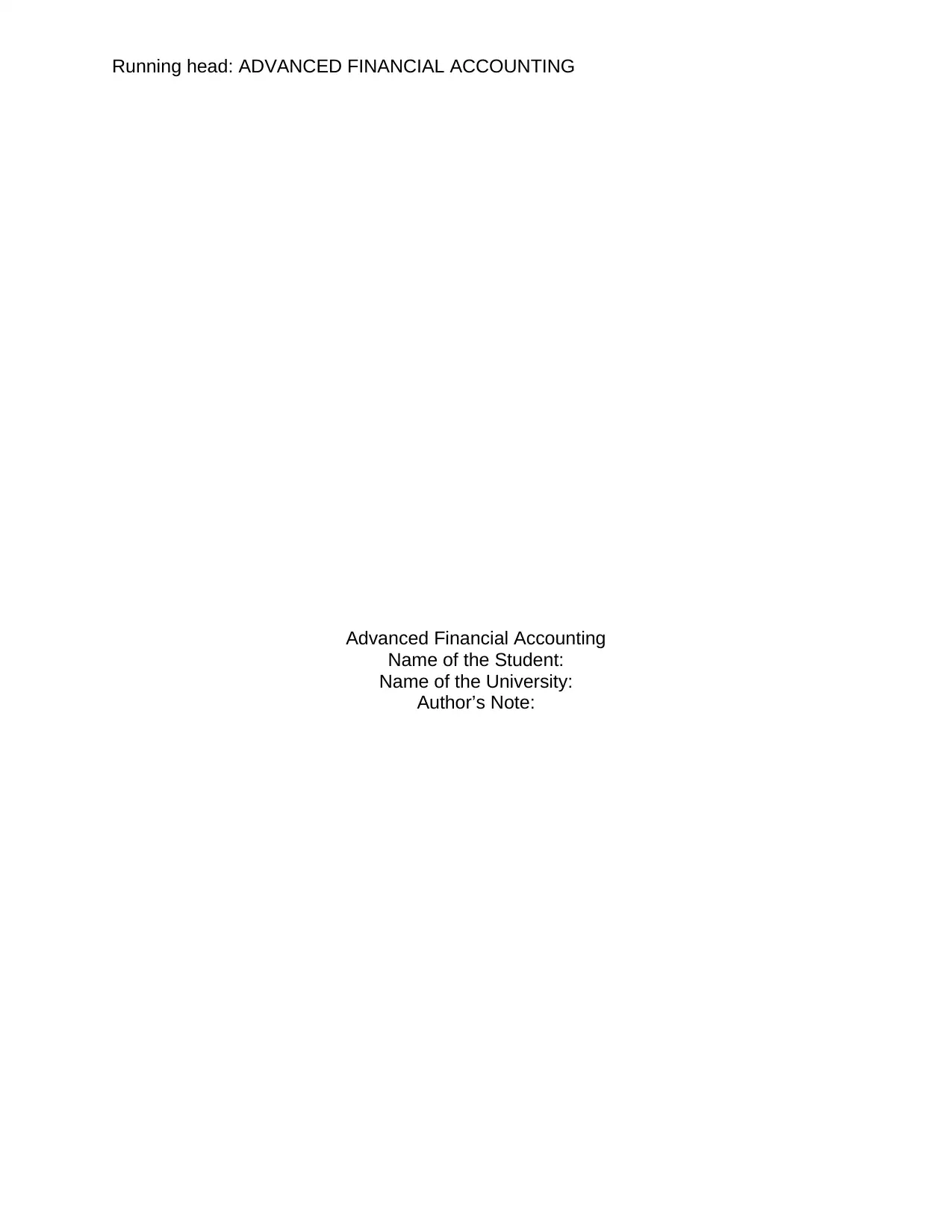
Running head: ADVANCED FINANCIAL ACCOUNTING
Advanced Financial Accounting
Name of the Student:
Name of the University:
Author’s Note:
Advanced Financial Accounting
Name of the Student:
Name of the University:
Author’s Note:
Paraphrase This Document
Need a fresh take? Get an instant paraphrase of this document with our AI Paraphraser
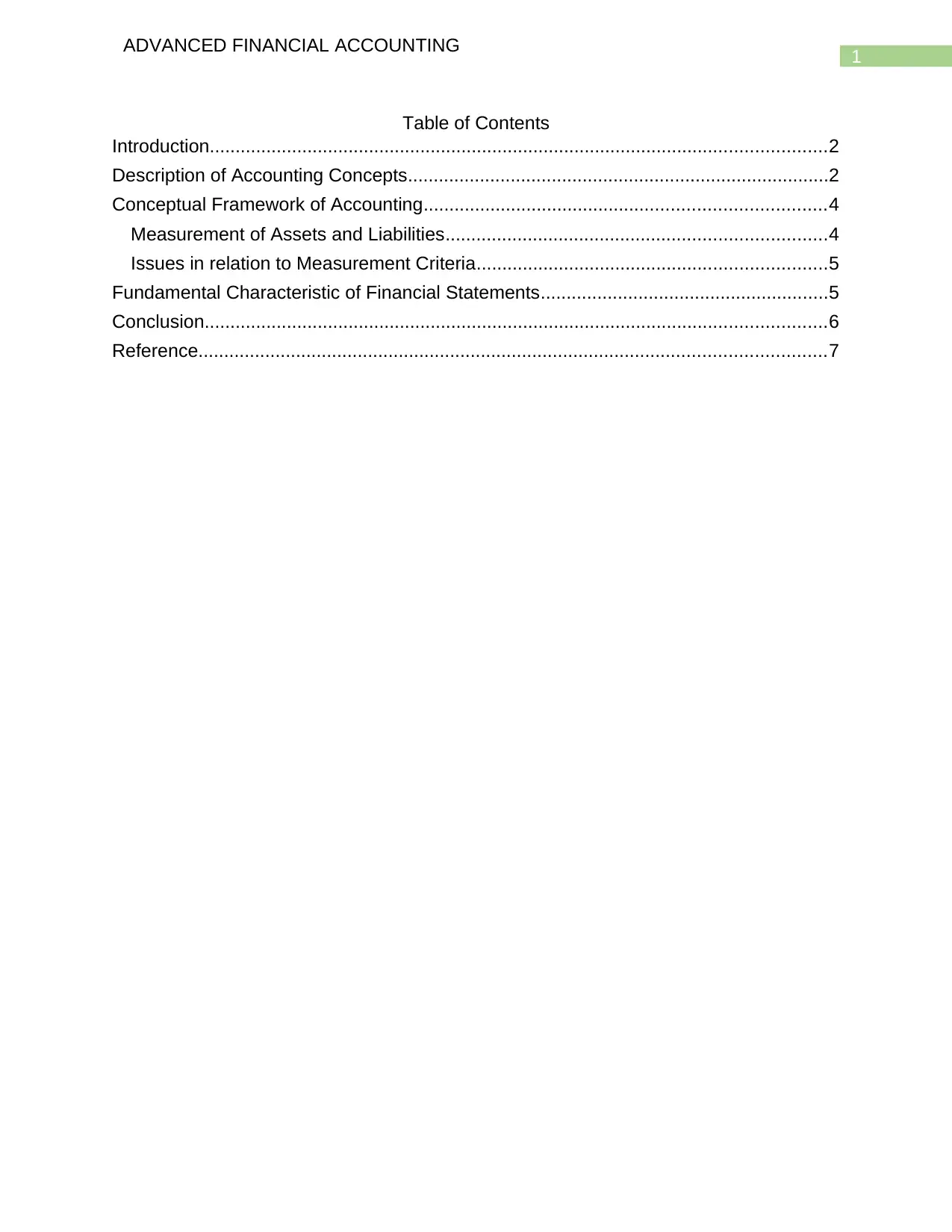
1
ADVANCED FINANCIAL ACCOUNTING
Table of Contents
Introduction........................................................................................................................2
Description of Accounting Concepts..................................................................................2
Conceptual Framework of Accounting..............................................................................4
Measurement of Assets and Liabilities..........................................................................4
Issues in relation to Measurement Criteria....................................................................5
Fundamental Characteristic of Financial Statements........................................................5
Conclusion.........................................................................................................................6
Reference..........................................................................................................................7
ADVANCED FINANCIAL ACCOUNTING
Table of Contents
Introduction........................................................................................................................2
Description of Accounting Concepts..................................................................................2
Conceptual Framework of Accounting..............................................................................4
Measurement of Assets and Liabilities..........................................................................4
Issues in relation to Measurement Criteria....................................................................5
Fundamental Characteristic of Financial Statements........................................................5
Conclusion.........................................................................................................................6
Reference..........................................................................................................................7
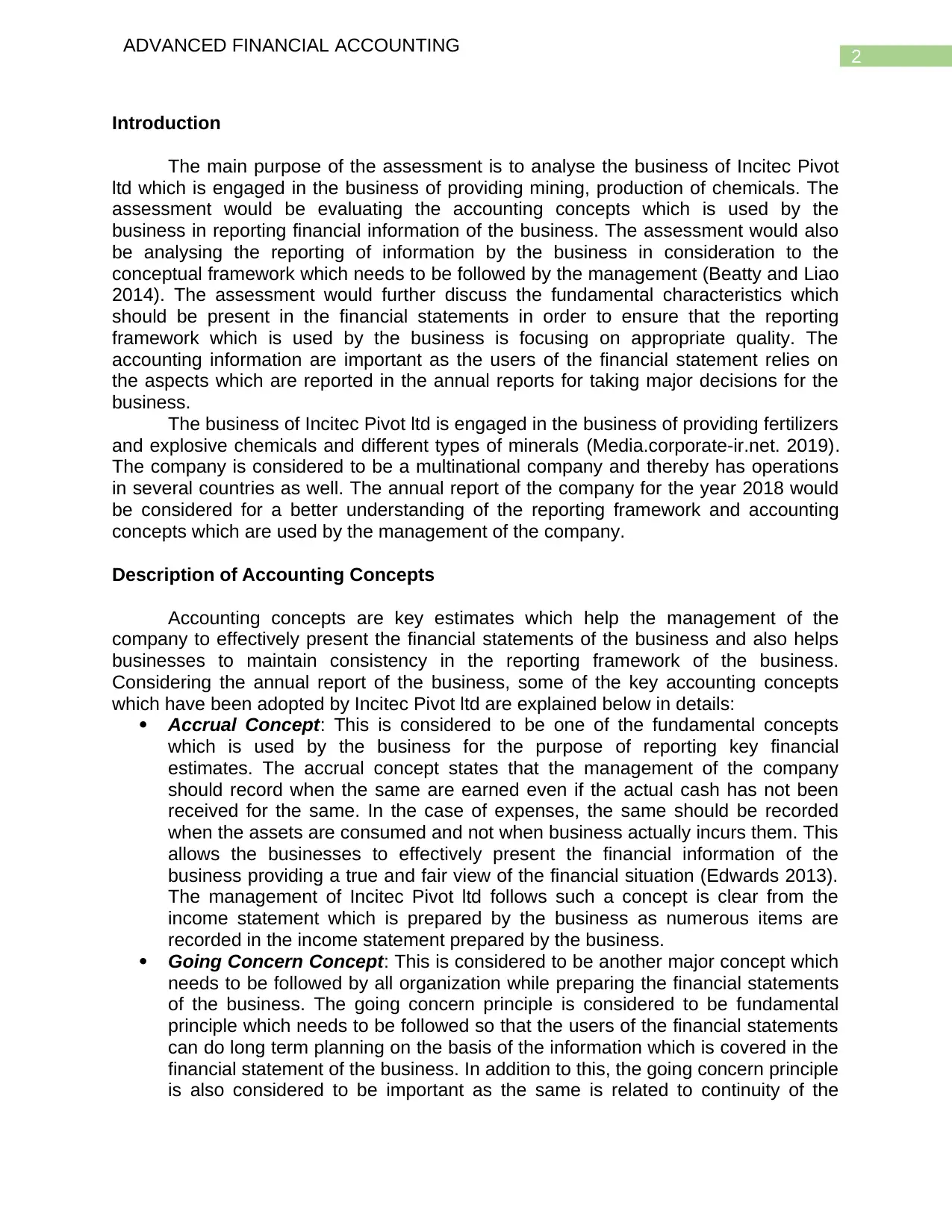
2
ADVANCED FINANCIAL ACCOUNTING
Introduction
The main purpose of the assessment is to analyse the business of Incitec Pivot
ltd which is engaged in the business of providing mining, production of chemicals. The
assessment would be evaluating the accounting concepts which is used by the
business in reporting financial information of the business. The assessment would also
be analysing the reporting of information by the business in consideration to the
conceptual framework which needs to be followed by the management (Beatty and Liao
2014). The assessment would further discuss the fundamental characteristics which
should be present in the financial statements in order to ensure that the reporting
framework which is used by the business is focusing on appropriate quality. The
accounting information are important as the users of the financial statement relies on
the aspects which are reported in the annual reports for taking major decisions for the
business.
The business of Incitec Pivot ltd is engaged in the business of providing fertilizers
and explosive chemicals and different types of minerals (Media.corporate-ir.net. 2019).
The company is considered to be a multinational company and thereby has operations
in several countries as well. The annual report of the company for the year 2018 would
be considered for a better understanding of the reporting framework and accounting
concepts which are used by the management of the company.
Description of Accounting Concepts
Accounting concepts are key estimates which help the management of the
company to effectively present the financial statements of the business and also helps
businesses to maintain consistency in the reporting framework of the business.
Considering the annual report of the business, some of the key accounting concepts
which have been adopted by Incitec Pivot ltd are explained below in details:
Accrual Concept: This is considered to be one of the fundamental concepts
which is used by the business for the purpose of reporting key financial
estimates. The accrual concept states that the management of the company
should record when the same are earned even if the actual cash has not been
received for the same. In the case of expenses, the same should be recorded
when the assets are consumed and not when business actually incurs them. This
allows the businesses to effectively present the financial information of the
business providing a true and fair view of the financial situation (Edwards 2013).
The management of Incitec Pivot ltd follows such a concept is clear from the
income statement which is prepared by the business as numerous items are
recorded in the income statement prepared by the business.
Going Concern Concept: This is considered to be another major concept which
needs to be followed by all organization while preparing the financial statements
of the business. The going concern principle is considered to be fundamental
principle which needs to be followed so that the users of the financial statements
can do long term planning on the basis of the information which is covered in the
financial statement of the business. In addition to this, the going concern principle
is also considered to be important as the same is related to continuity of the
ADVANCED FINANCIAL ACCOUNTING
Introduction
The main purpose of the assessment is to analyse the business of Incitec Pivot
ltd which is engaged in the business of providing mining, production of chemicals. The
assessment would be evaluating the accounting concepts which is used by the
business in reporting financial information of the business. The assessment would also
be analysing the reporting of information by the business in consideration to the
conceptual framework which needs to be followed by the management (Beatty and Liao
2014). The assessment would further discuss the fundamental characteristics which
should be present in the financial statements in order to ensure that the reporting
framework which is used by the business is focusing on appropriate quality. The
accounting information are important as the users of the financial statement relies on
the aspects which are reported in the annual reports for taking major decisions for the
business.
The business of Incitec Pivot ltd is engaged in the business of providing fertilizers
and explosive chemicals and different types of minerals (Media.corporate-ir.net. 2019).
The company is considered to be a multinational company and thereby has operations
in several countries as well. The annual report of the company for the year 2018 would
be considered for a better understanding of the reporting framework and accounting
concepts which are used by the management of the company.
Description of Accounting Concepts
Accounting concepts are key estimates which help the management of the
company to effectively present the financial statements of the business and also helps
businesses to maintain consistency in the reporting framework of the business.
Considering the annual report of the business, some of the key accounting concepts
which have been adopted by Incitec Pivot ltd are explained below in details:
Accrual Concept: This is considered to be one of the fundamental concepts
which is used by the business for the purpose of reporting key financial
estimates. The accrual concept states that the management of the company
should record when the same are earned even if the actual cash has not been
received for the same. In the case of expenses, the same should be recorded
when the assets are consumed and not when business actually incurs them. This
allows the businesses to effectively present the financial information of the
business providing a true and fair view of the financial situation (Edwards 2013).
The management of Incitec Pivot ltd follows such a concept is clear from the
income statement which is prepared by the business as numerous items are
recorded in the income statement prepared by the business.
Going Concern Concept: This is considered to be another major concept which
needs to be followed by all organization while preparing the financial statements
of the business. The going concern principle is considered to be fundamental
principle which needs to be followed so that the users of the financial statements
can do long term planning on the basis of the information which is covered in the
financial statement of the business. In addition to this, the going concern principle
is also considered to be important as the same is related to continuity of the
⊘ This is a preview!⊘
Do you want full access?
Subscribe today to unlock all pages.

Trusted by 1+ million students worldwide
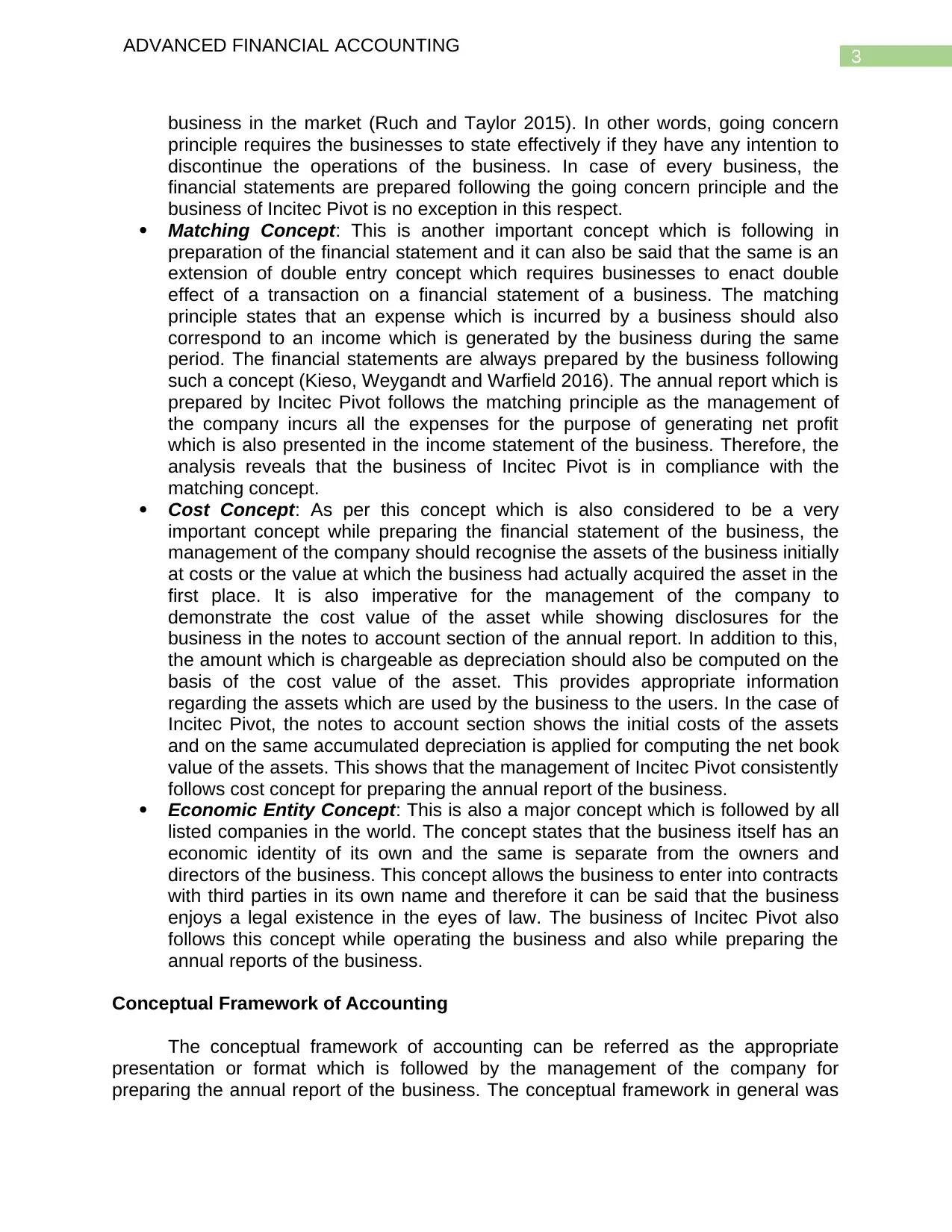
3
ADVANCED FINANCIAL ACCOUNTING
business in the market (Ruch and Taylor 2015). In other words, going concern
principle requires the businesses to state effectively if they have any intention to
discontinue the operations of the business. In case of every business, the
financial statements are prepared following the going concern principle and the
business of Incitec Pivot is no exception in this respect.
Matching Concept: This is another important concept which is following in
preparation of the financial statement and it can also be said that the same is an
extension of double entry concept which requires businesses to enact double
effect of a transaction on a financial statement of a business. The matching
principle states that an expense which is incurred by a business should also
correspond to an income which is generated by the business during the same
period. The financial statements are always prepared by the business following
such a concept (Kieso, Weygandt and Warfield 2016). The annual report which is
prepared by Incitec Pivot follows the matching principle as the management of
the company incurs all the expenses for the purpose of generating net profit
which is also presented in the income statement of the business. Therefore, the
analysis reveals that the business of Incitec Pivot is in compliance with the
matching concept.
Cost Concept: As per this concept which is also considered to be a very
important concept while preparing the financial statement of the business, the
management of the company should recognise the assets of the business initially
at costs or the value at which the business had actually acquired the asset in the
first place. It is also imperative for the management of the company to
demonstrate the cost value of the asset while showing disclosures for the
business in the notes to account section of the annual report. In addition to this,
the amount which is chargeable as depreciation should also be computed on the
basis of the cost value of the asset. This provides appropriate information
regarding the assets which are used by the business to the users. In the case of
Incitec Pivot, the notes to account section shows the initial costs of the assets
and on the same accumulated depreciation is applied for computing the net book
value of the assets. This shows that the management of Incitec Pivot consistently
follows cost concept for preparing the annual report of the business.
Economic Entity Concept: This is also a major concept which is followed by all
listed companies in the world. The concept states that the business itself has an
economic identity of its own and the same is separate from the owners and
directors of the business. This concept allows the business to enter into contracts
with third parties in its own name and therefore it can be said that the business
enjoys a legal existence in the eyes of law. The business of Incitec Pivot also
follows this concept while operating the business and also while preparing the
annual reports of the business.
Conceptual Framework of Accounting
The conceptual framework of accounting can be referred as the appropriate
presentation or format which is followed by the management of the company for
preparing the annual report of the business. The conceptual framework in general was
ADVANCED FINANCIAL ACCOUNTING
business in the market (Ruch and Taylor 2015). In other words, going concern
principle requires the businesses to state effectively if they have any intention to
discontinue the operations of the business. In case of every business, the
financial statements are prepared following the going concern principle and the
business of Incitec Pivot is no exception in this respect.
Matching Concept: This is another important concept which is following in
preparation of the financial statement and it can also be said that the same is an
extension of double entry concept which requires businesses to enact double
effect of a transaction on a financial statement of a business. The matching
principle states that an expense which is incurred by a business should also
correspond to an income which is generated by the business during the same
period. The financial statements are always prepared by the business following
such a concept (Kieso, Weygandt and Warfield 2016). The annual report which is
prepared by Incitec Pivot follows the matching principle as the management of
the company incurs all the expenses for the purpose of generating net profit
which is also presented in the income statement of the business. Therefore, the
analysis reveals that the business of Incitec Pivot is in compliance with the
matching concept.
Cost Concept: As per this concept which is also considered to be a very
important concept while preparing the financial statement of the business, the
management of the company should recognise the assets of the business initially
at costs or the value at which the business had actually acquired the asset in the
first place. It is also imperative for the management of the company to
demonstrate the cost value of the asset while showing disclosures for the
business in the notes to account section of the annual report. In addition to this,
the amount which is chargeable as depreciation should also be computed on the
basis of the cost value of the asset. This provides appropriate information
regarding the assets which are used by the business to the users. In the case of
Incitec Pivot, the notes to account section shows the initial costs of the assets
and on the same accumulated depreciation is applied for computing the net book
value of the assets. This shows that the management of Incitec Pivot consistently
follows cost concept for preparing the annual report of the business.
Economic Entity Concept: This is also a major concept which is followed by all
listed companies in the world. The concept states that the business itself has an
economic identity of its own and the same is separate from the owners and
directors of the business. This concept allows the business to enter into contracts
with third parties in its own name and therefore it can be said that the business
enjoys a legal existence in the eyes of law. The business of Incitec Pivot also
follows this concept while operating the business and also while preparing the
annual reports of the business.
Conceptual Framework of Accounting
The conceptual framework of accounting can be referred as the appropriate
presentation or format which is followed by the management of the company for
preparing the annual report of the business. The conceptual framework in general was
Paraphrase This Document
Need a fresh take? Get an instant paraphrase of this document with our AI Paraphraser
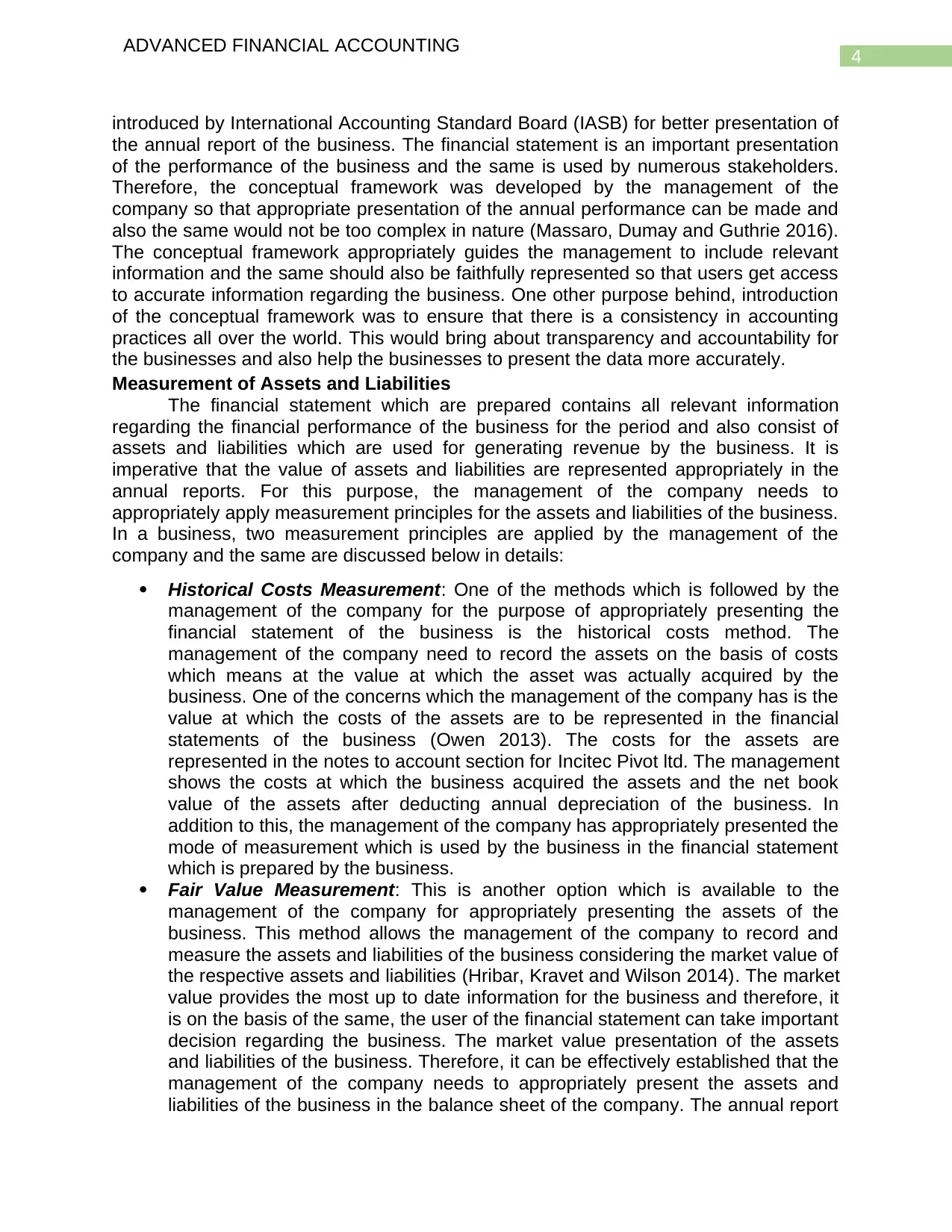
4
ADVANCED FINANCIAL ACCOUNTING
introduced by International Accounting Standard Board (IASB) for better presentation of
the annual report of the business. The financial statement is an important presentation
of the performance of the business and the same is used by numerous stakeholders.
Therefore, the conceptual framework was developed by the management of the
company so that appropriate presentation of the annual performance can be made and
also the same would not be too complex in nature (Massaro, Dumay and Guthrie 2016).
The conceptual framework appropriately guides the management to include relevant
information and the same should also be faithfully represented so that users get access
to accurate information regarding the business. One other purpose behind, introduction
of the conceptual framework was to ensure that there is a consistency in accounting
practices all over the world. This would bring about transparency and accountability for
the businesses and also help the businesses to present the data more accurately.
Measurement of Assets and Liabilities
The financial statement which are prepared contains all relevant information
regarding the financial performance of the business for the period and also consist of
assets and liabilities which are used for generating revenue by the business. It is
imperative that the value of assets and liabilities are represented appropriately in the
annual reports. For this purpose, the management of the company needs to
appropriately apply measurement principles for the assets and liabilities of the business.
In a business, two measurement principles are applied by the management of the
company and the same are discussed below in details:
Historical Costs Measurement: One of the methods which is followed by the
management of the company for the purpose of appropriately presenting the
financial statement of the business is the historical costs method. The
management of the company need to record the assets on the basis of costs
which means at the value at which the asset was actually acquired by the
business. One of the concerns which the management of the company has is the
value at which the costs of the assets are to be represented in the financial
statements of the business (Owen 2013). The costs for the assets are
represented in the notes to account section for Incitec Pivot ltd. The management
shows the costs at which the business acquired the assets and the net book
value of the assets after deducting annual depreciation of the business. In
addition to this, the management of the company has appropriately presented the
mode of measurement which is used by the business in the financial statement
which is prepared by the business.
Fair Value Measurement: This is another option which is available to the
management of the company for appropriately presenting the assets of the
business. This method allows the management of the company to record and
measure the assets and liabilities of the business considering the market value of
the respective assets and liabilities (Hribar, Kravet and Wilson 2014). The market
value provides the most up to date information for the business and therefore, it
is on the basis of the same, the user of the financial statement can take important
decision regarding the business. The market value presentation of the assets
and liabilities of the business. Therefore, it can be effectively established that the
management of the company needs to appropriately present the assets and
liabilities of the business in the balance sheet of the company. The annual report
ADVANCED FINANCIAL ACCOUNTING
introduced by International Accounting Standard Board (IASB) for better presentation of
the annual report of the business. The financial statement is an important presentation
of the performance of the business and the same is used by numerous stakeholders.
Therefore, the conceptual framework was developed by the management of the
company so that appropriate presentation of the annual performance can be made and
also the same would not be too complex in nature (Massaro, Dumay and Guthrie 2016).
The conceptual framework appropriately guides the management to include relevant
information and the same should also be faithfully represented so that users get access
to accurate information regarding the business. One other purpose behind, introduction
of the conceptual framework was to ensure that there is a consistency in accounting
practices all over the world. This would bring about transparency and accountability for
the businesses and also help the businesses to present the data more accurately.
Measurement of Assets and Liabilities
The financial statement which are prepared contains all relevant information
regarding the financial performance of the business for the period and also consist of
assets and liabilities which are used for generating revenue by the business. It is
imperative that the value of assets and liabilities are represented appropriately in the
annual reports. For this purpose, the management of the company needs to
appropriately apply measurement principles for the assets and liabilities of the business.
In a business, two measurement principles are applied by the management of the
company and the same are discussed below in details:
Historical Costs Measurement: One of the methods which is followed by the
management of the company for the purpose of appropriately presenting the
financial statement of the business is the historical costs method. The
management of the company need to record the assets on the basis of costs
which means at the value at which the asset was actually acquired by the
business. One of the concerns which the management of the company has is the
value at which the costs of the assets are to be represented in the financial
statements of the business (Owen 2013). The costs for the assets are
represented in the notes to account section for Incitec Pivot ltd. The management
shows the costs at which the business acquired the assets and the net book
value of the assets after deducting annual depreciation of the business. In
addition to this, the management of the company has appropriately presented the
mode of measurement which is used by the business in the financial statement
which is prepared by the business.
Fair Value Measurement: This is another option which is available to the
management of the company for appropriately presenting the assets of the
business. This method allows the management of the company to record and
measure the assets and liabilities of the business considering the market value of
the respective assets and liabilities (Hribar, Kravet and Wilson 2014). The market
value provides the most up to date information for the business and therefore, it
is on the basis of the same, the user of the financial statement can take important
decision regarding the business. The market value presentation of the assets
and liabilities of the business. Therefore, it can be effectively established that the
management of the company needs to appropriately present the assets and
liabilities of the business in the balance sheet of the company. The annual report
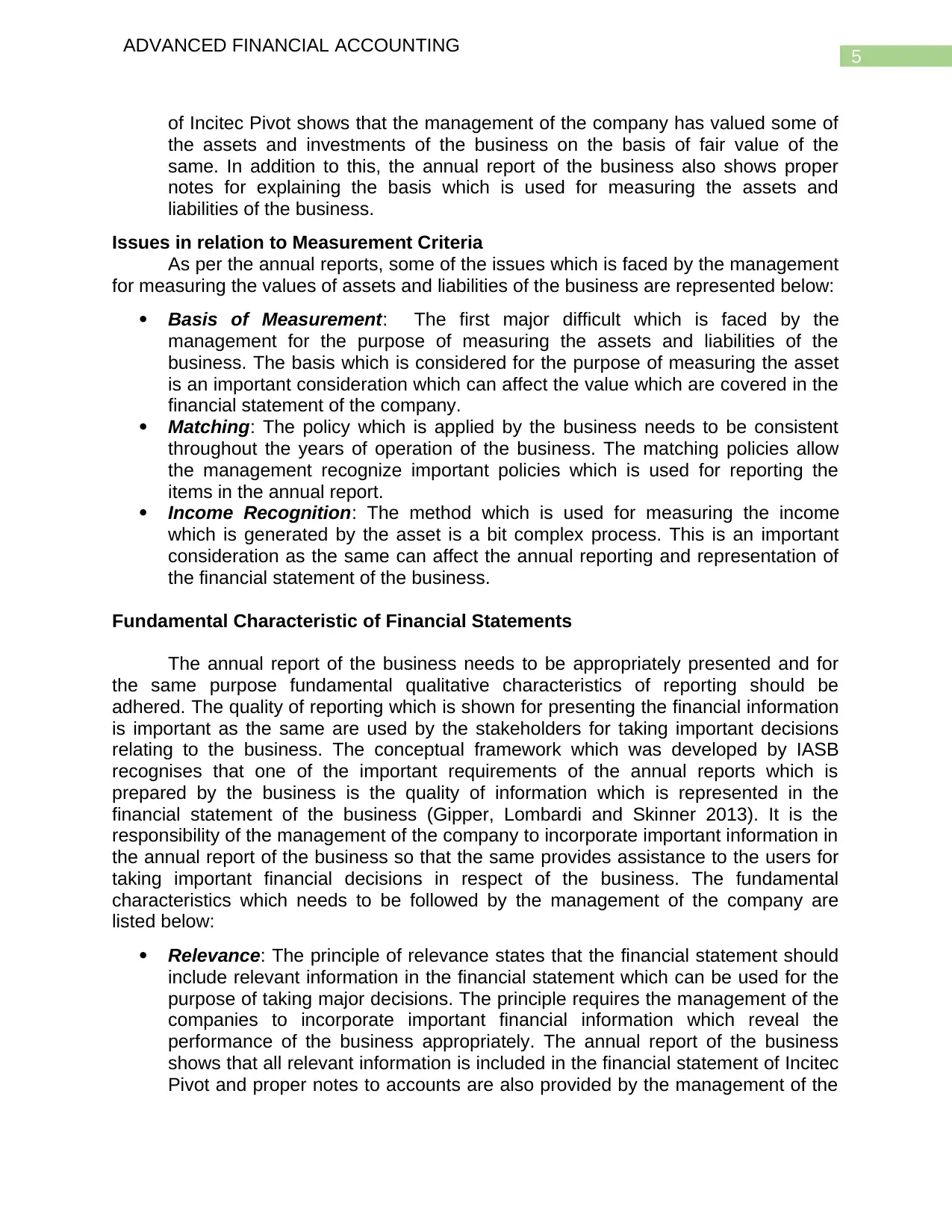
5
ADVANCED FINANCIAL ACCOUNTING
of Incitec Pivot shows that the management of the company has valued some of
the assets and investments of the business on the basis of fair value of the
same. In addition to this, the annual report of the business also shows proper
notes for explaining the basis which is used for measuring the assets and
liabilities of the business.
Issues in relation to Measurement Criteria
As per the annual reports, some of the issues which is faced by the management
for measuring the values of assets and liabilities of the business are represented below:
Basis of Measurement: The first major difficult which is faced by the
management for the purpose of measuring the assets and liabilities of the
business. The basis which is considered for the purpose of measuring the asset
is an important consideration which can affect the value which are covered in the
financial statement of the company.
Matching: The policy which is applied by the business needs to be consistent
throughout the years of operation of the business. The matching policies allow
the management recognize important policies which is used for reporting the
items in the annual report.
Income Recognition: The method which is used for measuring the income
which is generated by the asset is a bit complex process. This is an important
consideration as the same can affect the annual reporting and representation of
the financial statement of the business.
Fundamental Characteristic of Financial Statements
The annual report of the business needs to be appropriately presented and for
the same purpose fundamental qualitative characteristics of reporting should be
adhered. The quality of reporting which is shown for presenting the financial information
is important as the same are used by the stakeholders for taking important decisions
relating to the business. The conceptual framework which was developed by IASB
recognises that one of the important requirements of the annual reports which is
prepared by the business is the quality of information which is represented in the
financial statement of the business (Gipper, Lombardi and Skinner 2013). It is the
responsibility of the management of the company to incorporate important information in
the annual report of the business so that the same provides assistance to the users for
taking important financial decisions in respect of the business. The fundamental
characteristics which needs to be followed by the management of the company are
listed below:
Relevance: The principle of relevance states that the financial statement should
include relevant information in the financial statement which can be used for the
purpose of taking major decisions. The principle requires the management of the
companies to incorporate important financial information which reveal the
performance of the business appropriately. The annual report of the business
shows that all relevant information is included in the financial statement of Incitec
Pivot and proper notes to accounts are also provided by the management of the
ADVANCED FINANCIAL ACCOUNTING
of Incitec Pivot shows that the management of the company has valued some of
the assets and investments of the business on the basis of fair value of the
same. In addition to this, the annual report of the business also shows proper
notes for explaining the basis which is used for measuring the assets and
liabilities of the business.
Issues in relation to Measurement Criteria
As per the annual reports, some of the issues which is faced by the management
for measuring the values of assets and liabilities of the business are represented below:
Basis of Measurement: The first major difficult which is faced by the
management for the purpose of measuring the assets and liabilities of the
business. The basis which is considered for the purpose of measuring the asset
is an important consideration which can affect the value which are covered in the
financial statement of the company.
Matching: The policy which is applied by the business needs to be consistent
throughout the years of operation of the business. The matching policies allow
the management recognize important policies which is used for reporting the
items in the annual report.
Income Recognition: The method which is used for measuring the income
which is generated by the asset is a bit complex process. This is an important
consideration as the same can affect the annual reporting and representation of
the financial statement of the business.
Fundamental Characteristic of Financial Statements
The annual report of the business needs to be appropriately presented and for
the same purpose fundamental qualitative characteristics of reporting should be
adhered. The quality of reporting which is shown for presenting the financial information
is important as the same are used by the stakeholders for taking important decisions
relating to the business. The conceptual framework which was developed by IASB
recognises that one of the important requirements of the annual reports which is
prepared by the business is the quality of information which is represented in the
financial statement of the business (Gipper, Lombardi and Skinner 2013). It is the
responsibility of the management of the company to incorporate important information in
the annual report of the business so that the same provides assistance to the users for
taking important financial decisions in respect of the business. The fundamental
characteristics which needs to be followed by the management of the company are
listed below:
Relevance: The principle of relevance states that the financial statement should
include relevant information in the financial statement which can be used for the
purpose of taking major decisions. The principle requires the management of the
companies to incorporate important financial information which reveal the
performance of the business appropriately. The annual report of the business
shows that all relevant information is included in the financial statement of Incitec
Pivot and proper notes to accounts are also provided by the management of the
⊘ This is a preview!⊘
Do you want full access?
Subscribe today to unlock all pages.

Trusted by 1+ million students worldwide
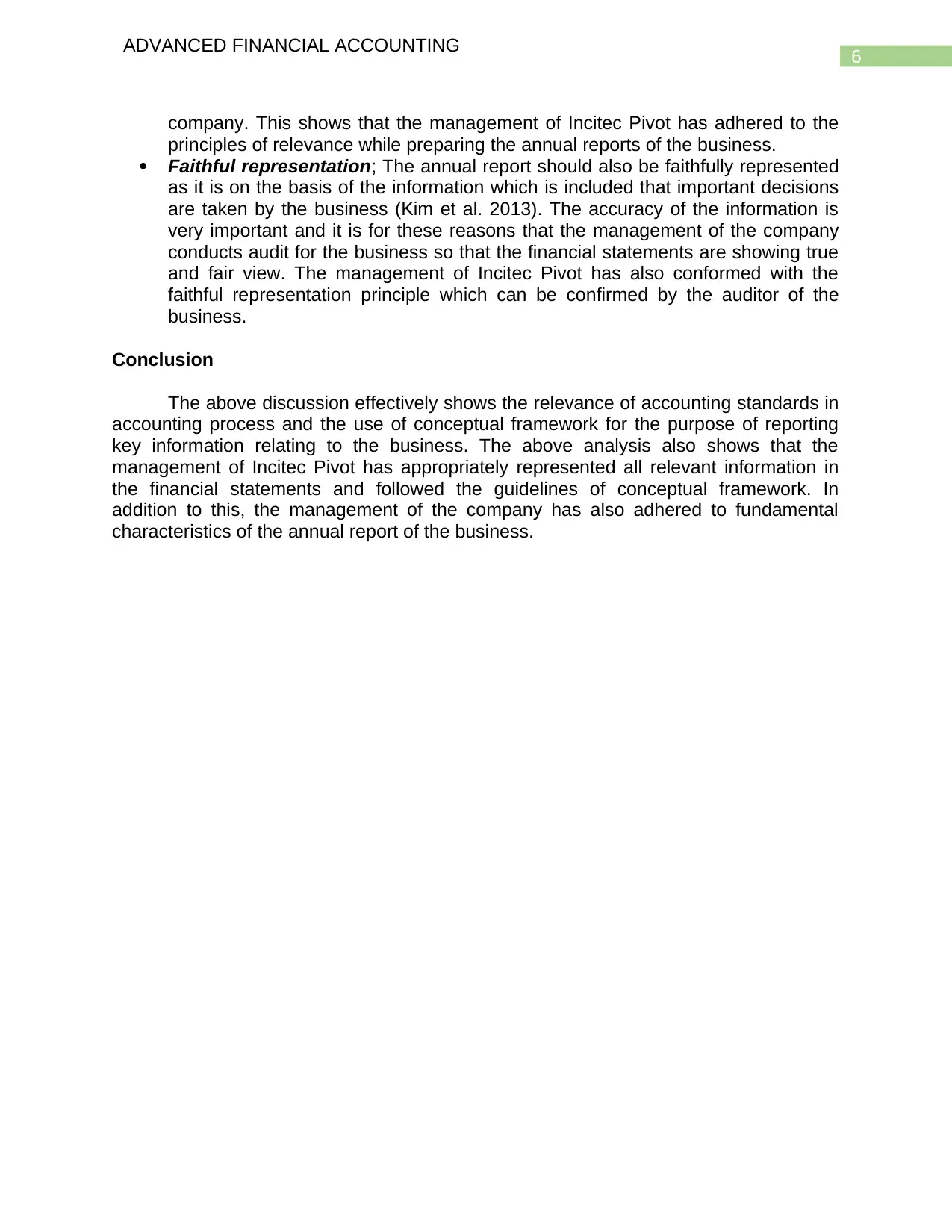
6
ADVANCED FINANCIAL ACCOUNTING
company. This shows that the management of Incitec Pivot has adhered to the
principles of relevance while preparing the annual reports of the business.
Faithful representation; The annual report should also be faithfully represented
as it is on the basis of the information which is included that important decisions
are taken by the business (Kim et al. 2013). The accuracy of the information is
very important and it is for these reasons that the management of the company
conducts audit for the business so that the financial statements are showing true
and fair view. The management of Incitec Pivot has also conformed with the
faithful representation principle which can be confirmed by the auditor of the
business.
Conclusion
The above discussion effectively shows the relevance of accounting standards in
accounting process and the use of conceptual framework for the purpose of reporting
key information relating to the business. The above analysis also shows that the
management of Incitec Pivot has appropriately represented all relevant information in
the financial statements and followed the guidelines of conceptual framework. In
addition to this, the management of the company has also adhered to fundamental
characteristics of the annual report of the business.
ADVANCED FINANCIAL ACCOUNTING
company. This shows that the management of Incitec Pivot has adhered to the
principles of relevance while preparing the annual reports of the business.
Faithful representation; The annual report should also be faithfully represented
as it is on the basis of the information which is included that important decisions
are taken by the business (Kim et al. 2013). The accuracy of the information is
very important and it is for these reasons that the management of the company
conducts audit for the business so that the financial statements are showing true
and fair view. The management of Incitec Pivot has also conformed with the
faithful representation principle which can be confirmed by the auditor of the
business.
Conclusion
The above discussion effectively shows the relevance of accounting standards in
accounting process and the use of conceptual framework for the purpose of reporting
key information relating to the business. The above analysis also shows that the
management of Incitec Pivot has appropriately represented all relevant information in
the financial statements and followed the guidelines of conceptual framework. In
addition to this, the management of the company has also adhered to fundamental
characteristics of the annual report of the business.
Paraphrase This Document
Need a fresh take? Get an instant paraphrase of this document with our AI Paraphraser
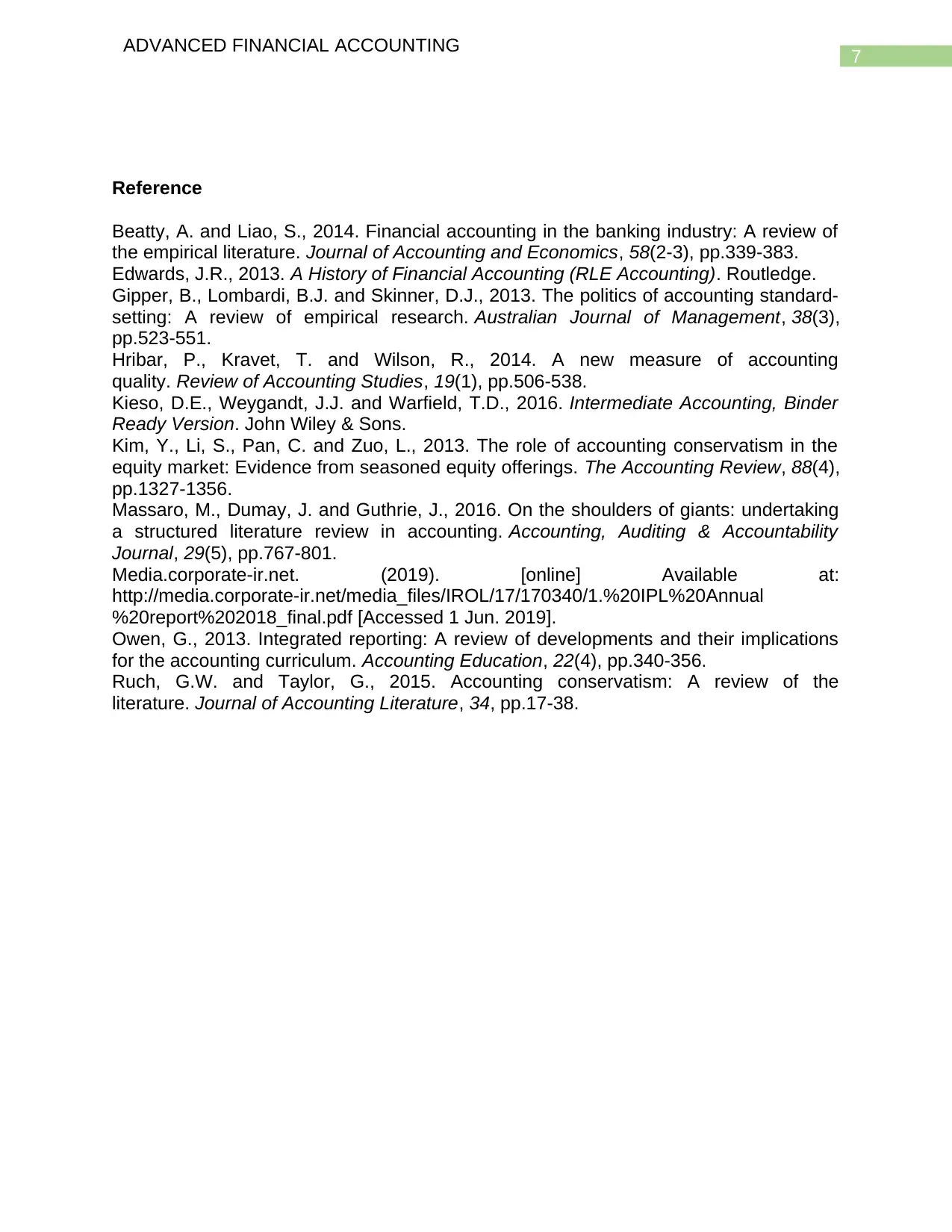
7
ADVANCED FINANCIAL ACCOUNTING
Reference
Beatty, A. and Liao, S., 2014. Financial accounting in the banking industry: A review of
the empirical literature. Journal of Accounting and Economics, 58(2-3), pp.339-383.
Edwards, J.R., 2013. A History of Financial Accounting (RLE Accounting). Routledge.
Gipper, B., Lombardi, B.J. and Skinner, D.J., 2013. The politics of accounting standard-
setting: A review of empirical research. Australian Journal of Management, 38(3),
pp.523-551.
Hribar, P., Kravet, T. and Wilson, R., 2014. A new measure of accounting
quality. Review of Accounting Studies, 19(1), pp.506-538.
Kieso, D.E., Weygandt, J.J. and Warfield, T.D., 2016. Intermediate Accounting, Binder
Ready Version. John Wiley & Sons.
Kim, Y., Li, S., Pan, C. and Zuo, L., 2013. The role of accounting conservatism in the
equity market: Evidence from seasoned equity offerings. The Accounting Review, 88(4),
pp.1327-1356.
Massaro, M., Dumay, J. and Guthrie, J., 2016. On the shoulders of giants: undertaking
a structured literature review in accounting. Accounting, Auditing & Accountability
Journal, 29(5), pp.767-801.
Media.corporate-ir.net. (2019). [online] Available at:
http://media.corporate-ir.net/media_files/IROL/17/170340/1.%20IPL%20Annual
%20report%202018_final.pdf [Accessed 1 Jun. 2019].
Owen, G., 2013. Integrated reporting: A review of developments and their implications
for the accounting curriculum. Accounting Education, 22(4), pp.340-356.
Ruch, G.W. and Taylor, G., 2015. Accounting conservatism: A review of the
literature. Journal of Accounting Literature, 34, pp.17-38.
ADVANCED FINANCIAL ACCOUNTING
Reference
Beatty, A. and Liao, S., 2014. Financial accounting in the banking industry: A review of
the empirical literature. Journal of Accounting and Economics, 58(2-3), pp.339-383.
Edwards, J.R., 2013. A History of Financial Accounting (RLE Accounting). Routledge.
Gipper, B., Lombardi, B.J. and Skinner, D.J., 2013. The politics of accounting standard-
setting: A review of empirical research. Australian Journal of Management, 38(3),
pp.523-551.
Hribar, P., Kravet, T. and Wilson, R., 2014. A new measure of accounting
quality. Review of Accounting Studies, 19(1), pp.506-538.
Kieso, D.E., Weygandt, J.J. and Warfield, T.D., 2016. Intermediate Accounting, Binder
Ready Version. John Wiley & Sons.
Kim, Y., Li, S., Pan, C. and Zuo, L., 2013. The role of accounting conservatism in the
equity market: Evidence from seasoned equity offerings. The Accounting Review, 88(4),
pp.1327-1356.
Massaro, M., Dumay, J. and Guthrie, J., 2016. On the shoulders of giants: undertaking
a structured literature review in accounting. Accounting, Auditing & Accountability
Journal, 29(5), pp.767-801.
Media.corporate-ir.net. (2019). [online] Available at:
http://media.corporate-ir.net/media_files/IROL/17/170340/1.%20IPL%20Annual
%20report%202018_final.pdf [Accessed 1 Jun. 2019].
Owen, G., 2013. Integrated reporting: A review of developments and their implications
for the accounting curriculum. Accounting Education, 22(4), pp.340-356.
Ruch, G.W. and Taylor, G., 2015. Accounting conservatism: A review of the
literature. Journal of Accounting Literature, 34, pp.17-38.
1 out of 8
Related Documents
Your All-in-One AI-Powered Toolkit for Academic Success.
+13062052269
info@desklib.com
Available 24*7 on WhatsApp / Email
![[object Object]](/_next/static/media/star-bottom.7253800d.svg)
Unlock your academic potential
Copyright © 2020–2025 A2Z Services. All Rights Reserved. Developed and managed by ZUCOL.





